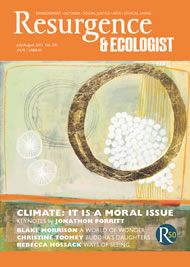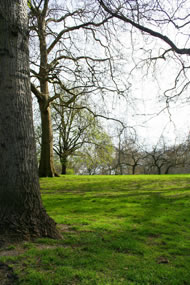Is it possible to turn a city into a national park? Will city dwellers – often unfairly derided by rural types as being hopelessly disconnected from Nature – embrace such a radical green vision? And how might it work? How might all of Nature benefit from it?
In February this year London’s Southbank Centre hosted a gathering of some 600 Londoners – everyone from students to urban planners, Nature-venture providers, educators, eco-warriors, social entrepreneurs, landscape architects, gardeners and curious passersby alike – turned out to show their support for a ‘Reimagine London’ campaign and explore these questions.
From the word ‘go’ we were hit with some astonishing facts: that London is 47 per cent green space, home to 13,000 species of wildlife and the world’s largest urban forest.
“There’s a sense that somehow the wild has to be pristine to be valued. But if you’re an individual flower, or pigeon or fox, you’re no less wild. There are just fewer of you, and you’ve learned to be in a city better than maybe other things. But that doesn’t make you any less valuable,’ said Daniel Raven-Ellison, the project’s founder, who organized and led the conference.
It’s a fantastic point, which adds ballast to the argument in favour: “The aim of the National Park City is to improve the lives of Londoners and visitors to London, no matter how many legs they have. It will share similar purposes to rural national parks and help people not only to benefit more from the capital's natural heritage, but also to act in ways that improve the liveability of the city itself too. It is important that it is called a National Park City because while it would have much in common with rural national parks, there is a significant difference,” he said.
A diverse range of speakers, among them MPs, a schoolgirl, an award-winning architect planner, and a sprinkling of CEOs, directors and professors were all on hand to voice their support. In the foyer, a large number of exhibitors championing the project had set up tables. It turns out that within London – which Raven-Ellison describes as a place of ‘hope, opportunity and potential’ – there lies an inexhaustible desire to power a notional park into a real one.
“The National Park City will promote, signpost and celebrate opportunities that already exist in the city. And it will help people to unlock the capital's natural potential by increasing biodiversity and the quality of its urban fabric. These improvements will in turn improve people's lives,” he said.
In the capital, we’re rich in natural beauty, with everything from semi-rural habitats to the more formal landscapes of central London parks, local open common lands and even green roofs, but we’re not always mindful of how we use these oases in our midst.
Peter Massini, from the Greater London Authority asked how we might add more ecological value to our green spaces, derive more benefit from them in terms of health and wellbeing and producing local food, and how we might use them as part of a transport network that encourages more walking. “These spaces are underused. How do we deliver benefits? How can we improve access to Nature?” he said.
Beth Collier, a Nature-based psychotherapist and founder of London’s Wild in the City, spoke of Nature deficit and how the project could tackle this: “We need London to be a National Park City to help raise awareness of the potential of Nature to provide enjoyment and support wellbeing. We need to promote Nature as a medicine which we can self-prescribe.”
So what’s next? In July, says Raven-Ellison, a full proposal will be published, together with a call for individuals and organizations to support it. “We will then be asking the Mayor of London, London Councils, charities, businesses, community groups and individuals to back the plan to make it happen. We do not need permission to make London a National Park City, but we do need legitimacy.”
The challenges ahead are undeniable: creating legislation for a new type of park, getting the full backing of the mayor (thus far Boris Johnson has praised the ‘inventiveness’ of the idea) and tackling issues around pollution and a growing population. But already momentum is growing and high profile supporters include TV presenter and naturalist Chris Packham and the MP Zac Goldsmith. The question remains, can we do it? Can we make the leap required to turn a beautiful vision into a fruitful, green future?
Judy Ling-Wong, CBE and Honorary President of the Black Environment Network offered a rallying cry on the day: “This is a big idea that goes beyond pure Nature conservation into social wellbeing – it brings us into the reality of life,” she said. “If we can crack it, it’s a tremendous gift to an urbanizing world.”
As a Londoner, I fervently hope that we can.
For more information visit: www.greaterlondonnationalpark.org.uk/








